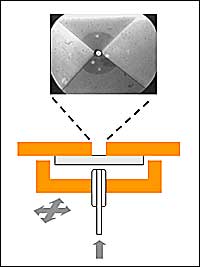Photo-detector with a very narrow bandwidth
Scientists have developed an extreme narrow bandwidth photo-detector for UV radiation.
Jun 5th, 2007
Read more
Scientists have developed an extreme narrow bandwidth photo-detector for UV radiation.
Jun 5th, 2007
Read moreThe Deutsche Forschungsgemeinschaft will establish eleven new Collaborative Research Centers, two of them in nanotechnology.
Jun 5th, 2007
Read moreThe union's declaration called for public debate, warning that products containing nanocomponents were being launched onto the market before civilian society and social movements had a chance to assess their possible implications in economic, environmental and social terms and their effect on human health.
Jun 4th, 2007
Read moreIn celebration of the 30th Anniversary of the Cornell NanoScale Science & Technology Facility (CNF) a one day event will take place on June 14, 2007 at the CNF in Ithaca, New York.
Jun 4th, 2007
Read moreThe U.S. President's Council of Advisors on Science and Technology has scheduled its next meeting on June 25 on the issues of nanotechnology applications and implications of nanotechnology for health, safety, and the environment.
Jun 4th, 2007
Read moreIncreasing numbers of nanotechnology companies see reverse mergers as relatively easy and inexpensive way to raise money, without having to meet listing requirements of an exchange and pay an underwriter for an IPO.
Jun 4th, 2007
Read moreToday, Harvard and Nano-Terra Inc., a company co-founded by Professor Whitesides, plan to announce the exclusive licensing for more than 50 current and pending Harvard patents to Nano-Terra.
Jun 4th, 2007
Read more Particles of light serving as "quantum keys" - the latest in encryption technology - have been sent over a record-setting 200-kilometer fiber-optic link
Particles of light serving as "quantum keys" - the latest in encryption technology - have been sent over a record-setting 200-kilometer fiber-optic link
Jun 3rd, 2007
Read moreResearchers have performed atomic spectroscopy with integrated optics on a chip for the first time, guiding a beam of light through a rubidium vapor cell integrated into a semiconductor chip.
Jun 1st, 2007
Read moreA safer method to deliver the insulin gene to diabetes patients using nanoparticles, was presented today at the 10th Annual Meeting of the American Society of Gene Therapy (ASGT) in Seattle.
Jun 1st, 2007
Read moreThe emerging nanotechnology field is gaining ground in the Czech Republic with successes reported by local researchers and the commercial sector.
Jun 1st, 2007
Read moreIf you are looking to balance all the good news and the hype about nanotechnology stocks with a real sober and negative take then you should read last Sunday's Berko column in The Oklahoman.
Jun 1st, 2007
Read moreCounterfeit products are depriving manufacturers of revenue, harming brand integrity and, in some cases, compromising safety. Accordingly, manufacturers and brand owners are fighting to keep phony goods out of their supply chains.
Jun 1st, 2007
Read moreThe Observatory for Micro and Nano Technologies (OMNT) has announced the setting up of a multidisciplinary working group responsible for providing a scientific watch on the effects of nanoparticles and nanomaterials on health and the environment.
Jun 1st, 2007
Read moreNissan opened a facility to explore cutting-edge science like nanotechnology in its quest for environmentally friendly vehicles.
Jun 1st, 2007
Read moreSurmounting several distinct hurdles to quantum computing, physicists have found that individual carbon-13 atoms in a diamond lattice can be manipulated with extraordinary precision to create stable quantum mechanical memory and a small quantum processor.
May 31st, 2007
Read more